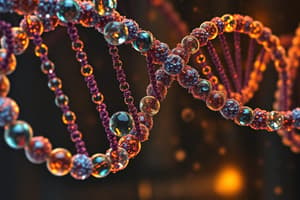Podcast
Questions and Answers
What is the role of topoisomerase in DNA replication?
What is the role of topoisomerase in DNA replication?
Topoisomerase relieves coiling by changing the DNA conformation from closed to open, and it cleaves the DNA to create a 5’phosphotyrosyl protein DNA linkage.
How can a single change in the amino acid sequence affect the phenotype?
How can a single change in the amino acid sequence affect the phenotype?
A single change in the amino acid sequence can lead to a change in the phenotype.
What is the cost and process involved in Sanger DNA sequencing?
What is the cost and process involved in Sanger DNA sequencing?
Sanger DNA sequencing costs $5 per 1000 base pairs and involves using PCR with fluorescent chain-terminating ddNTPs, size separation by capillary gel electrophoresis, and laser excitation for detection.
How does Next-Gen sequencing differ from Sanger sequencing?
How does Next-Gen sequencing differ from Sanger sequencing?
What is the advantage of Nanopore sequencing over traditional sequencing methods?
What is the advantage of Nanopore sequencing over traditional sequencing methods?
Explain the significance of a mutation in tyrosinase on pigment production.
Explain the significance of a mutation in tyrosinase on pigment production.
What is the role of helicase in DNA sequencing using nanopores?
What is the role of helicase in DNA sequencing using nanopores?
What are the differences between pyrimidines and purines in terms of their nucleoside structure?
What are the differences between pyrimidines and purines in terms of their nucleoside structure?
Explain the concept of epigenetics and how it differs from changes in the DNA sequence.
Explain the concept of epigenetics and how it differs from changes in the DNA sequence.
Describe the structure of DNA in terms of its antiparallel and complementary strands.
Describe the structure of DNA in terms of its antiparallel and complementary strands.
What is the function of topoisomerase type 2 in DNA metabolism?
What is the function of topoisomerase type 2 in DNA metabolism?
Differentiate between heterochromatin and euchromatin in terms of their structure and activity.
Differentiate between heterochromatin and euchromatin in terms of their structure and activity.
Flashcards are hidden until you start studying
Study Notes
Topoisomerase
- Relaxes DNA coiling by changing from a closed to an open conformation
- Active site attacks the phosphodiester bond in one DNA strand, creating a 5'phosphotyrosyl protein DNA linkage
- Unbroken DNA strand passes through the break in the first strand
- Enzyme conformation is held together by covalent bonds, making it harder to let go of the fragments
DNA Structure
- Hydrophilic sugars and phosphates on the outside, hydrophobic bases on the inside
- Chemically sound, with major and minor grooves
- Phosphodiester bond links from 5' to 3'
- A-form DNA is right-handed with a 20-degree base tilt, more compact with 11 over 10.5 helical bp per turn
- B-form DNA is right-handed with a 6-degree base tilt, more biologically relevant
- Z-form DNA is left-handed, not seen in biology, but in artificial synthesis
DNA Sequencing
- Sanger sequencing is reliable, reads 400-900 bp quickly, and costs $5 per 1000 bp
- Primers are required, and the process involves PCR, fluorescent chain-terminating ddNTPs, and size separation by capillary gel electrophoresis
- Next-generation sequencing reads multiple spots at once, does not require primers, and costs $5 per GB with 99% accuracy
- Nanopore sequencing uses a machine that reads a single strand of DNA at a time, with different nucleotides disrupting to give different readings
Nucleosides and Bases
- Pyrimidines include C and T, with deoxycytidine and deoxythymidine as their nucleosides
- Purines include G and A, with deoxyguanosine and deoxyadenosine as their nucleosides
- Uracil is an RNA base
- Adenine dinucleotides include NADPH and NADH
Epigenetics
- Epigenetic changes can be inherited but do not have a change in the DNA sequence
- Methyl groups are added to bases as it goes through tRNA, giving more stability from degradation
- Modifications can be inherited through parents' alleles, even if silent or dominant
Chromatin
- Chromatin is composed of equal fibers of protein and DNA, coiled around histones
- Histones are small proteins with positive charge and no genetic information
- Heterochromatin wraps around histones, while euchromatin has an open reading frame and is active DNA
- Histones have a tail that can be methylated or acetylated, allowing them to wrap around each other
DNA Metabolism
- Distinguish types of DNA polymerase, helicase, and other enzymes involved in DNA metabolism
- Double-strand breaks can inhibit replication, requiring non-homologous end joining or other repair mechanisms
Studying That Suits You
Use AI to generate personalized quizzes and flashcards to suit your learning preferences.



